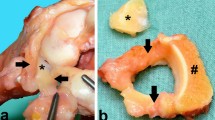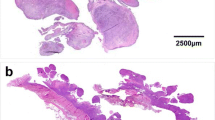Abstract
Introduction
Degenerative articular disc perforations of the triangular fibrocartilage (TFC) of the wrist are characterized by fibrocartilage cell loss and are often associated with ulna-plus situations. Apoptosis has been found to play a crucial role in fibrocartilage cell loss, however, the molecular mechanism and mediators are still poorly understood.
Aim
The purpose of this study was to identify receptors to apoptosis in degenerative disc lesions.
Patients
Included in the study were 17 patients with degenerative articular disc tears of the TFC (Palmer type 2C). Following arthroscopic debridement of the TFC, histological sections were examined to assess the presence of apoptosis. Apoptosis was determined using TRAIL and death receptor DR4 agonists for immunohistochemical analyses. The number of cells positive for apoptosis was then correlated with ulna length.
Results
Cells positive for TRAIL and DR4 were found in all specimens. The number of cells positive for TRAIL was significantly increased in specimens of patients with an ulna positive variance (P = 0.040). However, DR4 was not significantly increased in ulna plus (P > 0.05). Both, TRAIL and DR4 positive cells were found to be evenly distributed throughout each specimen. There was no accumulation of any type of cells in any particular zone of the biopsies.
Conclusion
This is the first study that shows that TFCC cells express TRAIL and DR4, which suggests that apoptosis, as well as, mechanical trauma are involved in the development of disc perforation. The TRAIL/DR4 receptor system is a molecular mediator of apoptosis induction in TFC cells and therefore plays a role in cell loss in degenerative disc lesions.



Similar content being viewed by others
References
Palmer AK (1989) Triangular fibrocartilage complex lesions: a classification. J Hand Surg [Am] 14(4):594–606
Palmer AK, Werner FW (1981) The triangular fibrocartilage complex of the wrist—anatomy and function. J Hand Surg [Am] 6(2):153–162
Mikic ZD (1989) Detailed anatomy of the articular disc of the distal radioulnar joint. Clin Orthop Relat Res 245:123–132
Unglaub F, Fellenberg J, Germann G, Bickert B, Sauerbier M, Richter W (2007) Detection of apoptotic cartilage cells in symptomatic central tears of the triangular fibrocartilage. J Hand Surg [Am] 32(5):618–622
Unglaub F, Wolf MB, Thome MA, Germann G, Sauerbier M, Reiter A (2008) Correlation of ulnar length and apoptotic cell death in degenerative lesions of the triangular fibrocartilage. Arthroscopy 24(3):299–304
Unglaub F, Thomas S, Kroeber M, Dragu A, Fellenberg J, Wolf MB et al (2009) Apoptotic pathways in degenerative disc lesions in the wrist. Arthroscopy 25(12):1380–1386
Wiley SR, Schooley K, Smolak PJ, Din WS, Huang CP, Nicholl JK et al (1995) Identification and characterization of a new member of the TNF family that induces apoptosis. Immunity 3(6):673–682
Bertram H, Nerlich A, Omlor G, Geiger F, Zimmermann G, Fellenberg J (2009) Expression of TRAIL and the death receptors DR4 and DR5 correlates with progression of degeneration in human intervertebral disks. Mod Pathol 22(7):895–905
Zhang L, Niu T, Yang SY, Lu Z, Chen B (2008) The occurrence and regional distribution of DR4 on herniated disc cells: a potential apoptosis pathway in lumbar intervertebral disc. Spine (Phila Pa 1976) 33(4):422–427
Chen B, Fellenberg J, Wang H, Carstens C, Richter W (2005) Occurrence and regional distribution of apoptosis in scoliotic discs. Spine 30(5):519–524
Tatebe M, Horii E, Nakao E, Shinohara T, Imaeda T, Nakamura R et al (2007) Repair of the triangular fibrocartilage complex after ulnar-shortening osteotomy: second-look arthroscopy. J Hand Surg [Am] 32(4):445–449
Bednar MS, Arnoczky SP, Weiland AJ (1991) The microvasculature of the triangular fibrocartilage complex: its clinical significance. J Hand Surg [Am] 16(6):1101–1105
Wolf MB, Kroeber MW, Reiter A, Thomas SB, Hahn P, Horch RE et al (2008) Ulnar shortening after TFCC suture repair of Palmer type 1B lesions. Arch Orthop Trauma Surg [Epub ahead of print]
Unglaub F, Kroeber MW, Thomas SB, Wolf MB, Arkudas A, Dragu A et al (2009) Incidence and distribution of blood vessels in punch biopsies of Palmer 1A disc lesions in the wrist. Arch Orthop Trauma Surg 129(5):631–634
Estrella EP, Hung LK, Ho PC, Tse WL (2007) Arthroscopic repair of triangular fibrocartilage complex tears. Arthroscopy 23(7):729–737
Reiter A, Wolf MB, Schmid U, Frigge A, Dreyhaupt J, Hahn P et al (2008) Arthroscopic repair of Palmer 1B triangular fibrocartilage complex tears. Arthroscopy 24(11):1244–1250
Lavrik IN, Golks A, Krammer PH (2005) Caspases: pharmacological manipulation of cell death. J Clin Invest 115(10):2665–2672
Green DR, Kroemer G (2005) Pharmacological manipulation of cell death: clinical applications in sight? J Clin Invest 115(10):2610–2617
Demjen D, Klussmann S, Kleber S, Zuliani C, Stieltjes B, Metzger C et al (2004) Neutralization of CD95 ligand promotes regeneration and functional recovery after spinal cord injury. Nat Med 10(4):389–395
Dang AC, Warren AP, Kim HT (2006) Beneficial effects of intra-articular caspase inhibition therapy following osteochondral injury. Osteoarthritis Cartilage 14(6):526–532
D’Lima D, Hermida J, Hashimoto S, Colwell C, Lotz M (2006) Caspase inhibitors reduce severity of cartilage lesions in experimental osteoarthritis. Arthritis Rheum 54(6):1814–1821
Costouros JG, Kim HT (2007) Preventing chondrocyte programmed cell death caused by iatrogenic injury. Knee 14(2):107–111
Park JB, Park IC, Park SJ, Jin HO, Lee JK, Riew KD (2006) Anti-apoptotic effects of caspase inhibitors on rat intervertebral disc cells. J Bone Joint Surg Am 88(4):771–779
Xu R, Shao Z, Xiong L (2008) Experimental study on inhibitory effect of niacinamide on tumor necrosis factor-alpha-induced matrix degradation of annulus fibrous tissue in vitro. J Huazhong Univ Sci Technolog Med Sci 28(5):576–579
Nuttall ME, Nadeau DP, Fisher PW, Wang F, Keller PM, DeWolf WE Jr et al (2000) Inhibition of caspase-3-like activity prevents apoptosis while retaining functionality of human chondrocytes in vitro. J Orthop Res 18(3):356–363
Acknowledgments
The study was supported by the ELAN Fonds, University of Erlangen, Germany.
Conflict of interest statement
None.
Author information
Authors and Affiliations
Corresponding author
Additional information
F. Unglaub and S. B. Thomas contributed equally to this work.
Rights and permissions
About this article
Cite this article
Unglaub, F., Thomas, S.B., Kroeber, M.W. et al. Expression of TRAIL and death receptor DR4 in Palmer type 2 TFCC lesions. Arch Orthop Trauma Surg 130, 1215–1220 (2010). https://doi.org/10.1007/s00402-009-0988-4
Received:
Published:
Issue Date:
DOI: https://doi.org/10.1007/s00402-009-0988-4




